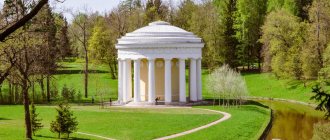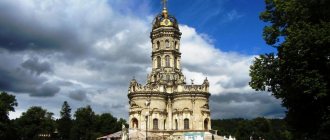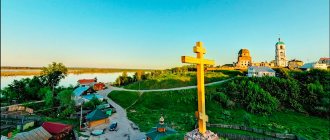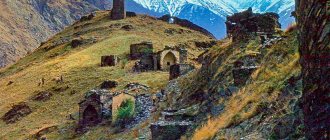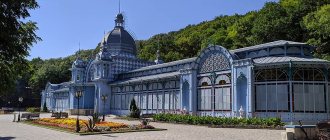> Countries Italy
Milan is the capital of Lombardy and northern Italy. It is unlike other Italian cities and is the site of important historical events dating back to the Roman Empire and the cradle of Italian culture with many important historical monuments. The architectural heritage includes dozens of ancient Romanesque churches, unique Gothic cathedrals, magnificent Baroque and neoclassical buildings and graceful Art Deco buildings.
- Sights of Milan
- Excursions
- How to get there
- Map
Milan Cathedral
The main attraction of the city is the Milan Cathedral Duomo (Duomo di Milano). Italy is proud of its outstanding temple, which has an impressive size and solemn decoration. It took the city authorities more than 6 centuries (1386-1965) to build the grandiose Catholic church! The snow-white building is made at the junction of different styles, but most of all one can feel the “flaming Gothic”. The combination of narrow spiers reaching into the sky, elaborate small decorations and a large number of statues makes a powerful impression.
There is an observation deck along the perimeter of the roof, which offers incredible views of the city. A great place for photography and video shooting! The highest point of the cathedral is a 106.5 m high spire, decorated with a gilded statue of the Madonna. The temple is designed for 40 thousand parishioners, which puts it third in the world in terms of capacity. And in terms of size, the Duomo is the fifth largest in the world!
Bosco Verticale
Bosco Verticale
Vertical Forest (Bosco Verticale) is an unusual residential complex consisting of two landscaped towers, 110 and 76 meters high, which house 113 apartments with incredible views of the city.
Two modern skyscrapers were built in Milan's Porta Nuova district from 2009 to 2014 by Italian architects Stefano Boeri, Gianandrea Barreca and Giovanni La Varra.
The peculiarity of these skyscrapers is that about 900 trees, 5,000 shrubs and 11 thousand grass paths are planted on the terraces of each floor.
Bosco Verticale is striking in that all its plants in this complex, as well as their location, are carefully selected.
This structure changes its appearance depending on the time of year: spring flowering, summer greenery and autumn withering serve as a kind of decoration that changes in dynamics.
In addition, two 27-story skyscrapers replace a classic park area with an area of 50 thousand square meters.
And the efforts of the architects were not in vain: in 2014, two Bosco Verticale towers were recognized as the best skyscrapers of the year, receiving the International Highrise Award.
How to get to Bosco Verticale You can get to Bosco Verticale by metro line M2 to Gioia station or by metro line M5 to Isola station. Bosco Verticale address: Via Gaetano de Castillia, 17.
Gallery of Victor Emmanuel II
Having managed to enjoy the unreal beauty of the Duomo, the traveler will want to stroll along the Cathedral Square (Piazza del Duomo) and take a closer look at the other beauties of Milan. To the left of the white marble cathedral there is a portal leading to the Gallery of Victor Emmanuel II (Galleria Vittorio Emanuele II). The intersection of two streets was turned into a neoclassical arcade, covered with a convex glass dome. There was brisk trade inside, bakeries and shops opened.
Construction of the gallery took place from 1865 to 1877 under the direction of the architect Giuseppe Mengoni. If you look at the gallery from a bird's eye view, you can easily guess the Latin cross in the shape of the building. It is noteworthy that the triumphal arch installed on Gathering Square is dedicated to the unification of the country. Italy found its first ruler in the person of King Victor Emmanuel II, after whom the passage was named.
Modern tourists are attracted by the translucent roof of the gallery, which provides muted light. Mosaic drawings on the vaults of the building depict the world's continents, science, agriculture, art and technological progress. The old shops in the arcade have been replaced by expensive boutiques and high-status restaurants. Italians do not forget about the cultural significance of the gallery; they often organize concerts, exhibitions and shows under the canopy of glass roofs.
Try the most delicious ice cream
To be in Italy and not eat ice cream is almost indecent. How about a quest to find the tastiest thing? The Il Massimo Del Gelato cafe will set the bar high: there are 8 types of chocolate ice cream alone - with different amounts of cocoa and a fireworks of spices. Azteco with cinnamon and chili, Giamaica with rum and Fiji with Grand Marnier cognac and orange zest challenge those with a sweet tooth.
Also in Milan, six gelaterias of the famous GROM chain await you. Its founders, Guido Martinetti and Federico Grom, are known for their fanatical attention to the selection of natural ingredients: in search of the ideal taste for peach sorbet, they grew 8 varieties of peaches! Every month GROM has new signature desserts: granita made from Sicilian lemons saves you from the heat, and Apple Pie with apples, cinnamon and biscotti crumbs gives you the Christmas mood. Pistachio, coffee and salted caramel ice creams instantly disappear from the cup at any time of the year.
Find cheap flights to Milan
Find the best hotel in Milan
La Scala Theater
If you cross the Gallery of Victor Emmanuel II from north to south, you can get from the Cathedral Square to Piazza della Scala.
It is there that the world's most famous opera house, La Scala, is located. Paradoxically, at first glance the building does not make much of an impression. The building, modest in appearance, reveals its splendor only to a select few who are allowed inside. The huge hall with excellent acoustics has become a standard example of an opera house. Within the walls of La Scala operas by recognized authors are performed: “Madama Butterfly”, “Turandot” by Giacomo Puccini, “Nabucco”, “Othello”, “Oberto” by Giuseppe Verdi, “The Pirate”, “Norma” by Vincenzo Bellini (Vincenzo Bellini).
The owners of incredible operatic voices performed on the theater stage: Enrico Caruso, Maria Callas, Renata Tebaldi, Franco Corelli, Mario Del Monaco, Fyodor Chaliapin and many other. You can plunge into the history of the great Italian opera at the La Scala Theater Museum, opened at the theater.
Best time to travel
The tourist season in Milan lasts all year round. The largest number of tourists come to Milan in the summer months. During this period, the temperature in the city is quite high (on average 27 °C), but this does not frighten travelers.
However, the ideal time to visit the city depends on the purpose of your trip. So, if you are a shopping lover and want to visit stores of world famous brands, then you should come to Milan during the sales season. The first, as a rule, begins after the Christmas holidays and ends before the beginning of Lent. And the second season begins at the beginning of July and ends at the end of August. The exact start and end dates of sales are approved by the local government. During this time, you can buy unique branded products at a discount of up to 70%.
There are simply a huge number of tourists in the city, so buy plane tickets in advance and prepare to stand in lines for hours.
If you are a fan of opera and dream of going to the great temple of culture - the La Scala Opera House, then come to Milan in December. The theater season opens on December 7, but make sure to purchase your tickets in advance. On the same day (December 7), you will be able to witness one of the main holidays in Milan - the day of St. Ambrose, the patron saint of the city. In the morning, a solemn liturgy takes place in the Basilica of St. Ambrose. And opposite the Sforzesco Castle you can visit the fair beloved by the residents of Milan. They sell delicious sweets, antiques, clothing and a variety of Christmas gifts and decorations.
The fair in honor of St. Ambrose's Day takes place over three days.
A large number of tourists come to Milan in February. The purpose of their trip is to visit the colorful Ambrosian Carnival. It takes place during Maslenitsa week. Having visited it, you can not only watch the colorful procession of residents in bright costumes, but also try traditional sweets, as well as attend a large number of free theatrical performances and parties.
The Ambrosian Carnival is one of the most exciting events in Milan
Poldi Pezzoli Museum
In the 19th century, Gian Giacomo Poldi Pezzoli collected an impressive collection of paintings, sculptures, tapestries, furnishings, weapons, and armor. After his death, Poldi-Pezoli bequeathed his property to the public. Since 1881, the mansion of the Italian nobleman has been turned into a museum (Museo Poldi Pezzoli), open to everyone.
The walls of the house-museum, painted with dark red paint, display several hundred paintings by Italian painters. Luxury items, elegant interiors, antique ceramics, and military equipment make up a rich and somewhat eclectic exhibition. By the way, the Poldi Pezzoli Museum is a 15-minute walk from La Scala Theatre.
Try the famous panzerotti
There is one thing in Milan that neither office clerks, nor students, nor beauties in high heels, nor lathered tourists, nor even respectable elderly couples can resist. Everyone is equal before Luini's panzerotti! These hearty Italian pies, which have long become a favorite fast food for Milanese, clearly have something mixed in: you want to eat them instead of breakfast, lunch and dinner.
Find cheap flights to Milan
Find the best hotel in Milan
Ambrosiana Library
Saint Ambrose has been the patron saint of the city of Milan for the last 15 centuries. Lived in the 4th century AD. Bishop Ambrose of Milan (lat. Ambrosius Mediolanensis) had great weight in church circles. Those in power listened to his words, and the common people respected the miracle-working bishop. Opened in 1609, the public library (Biblioteca Ambrosiana) was named after the city's patron saint.
The Ambrosian Library is located in the two-story building of the Ambrosian Palace (Palazzo Ambrosiana). During the Middle Ages, the library was filled with the most valuable exhibits: an ancient copy of the Iliad, dated to the 5th century AD, a collection of poems by the Roman poet Virgil (lat. Publius Vergilius Maro), supplemented by illustrations by the 14th century artist Simone Martini, manuscripts of Leonardo da Vinci (Leonardo di ser Piero da Vinci), the works of Francesco Petrarca.
Pinacoteca Ambrosiana
Under the roof of the Palazzo Ambrosiana, back in the 17th century, the Academy and the Pinacoteca (Pinacoteca Ambrosiana) were also located. The latest discovery by the curators of the complex is the Medioteka, which stores digital samples of art objects. The Pinakothek is a public art gallery founded in 1618. The founder of the gallery, Federico Borromeo, considered it necessary to instill in students a taste for beauty.
The Pinakothek consists of 23 halls, which are distinguished by modest decoration. All the attention of tourists should be focused on the paintings. The collection contains paintings and sketches that once belonged to Borromeo himself. Among the most valuable works are paintings by Tiziano Vecellio, Rembrandt (Dutch Rembrandt Harmenszoon van Rijn), “The Musician” by Leonardo da Vinci, a copy of the famous fresco “The Last Supper”, “Madonna under the Canopy” by Sandro Botticelli. , sketches “School in Athens” by Raphael Santi (Raffaello Santi), incredibly realistic still life “Fruit Basket” by Caravaggio (Michelangelo Merisi da Caravaggio).
On the map of the city, the Ambrosian Palace is listed at the address: Milano, Piazza Pio XI, 2. Exhibitions are open from Tuesday to Sunday from 10:00 to 18:00. On major church holidays the palace is closed. Ticket price is 15 euros. Before your visit, check that the information is up-to-date on the official website of the museum: www.ambrosiana.eu
Sights of Milan: what else to visit in Milan?
We told you about the main attractions of Milan briefly. In addition to them, we recommend that you visit such interesting places and objects of the Italian city as:
Leonardo da Vinci Museum of Science and Technology
National Museum of Science and Technology Leonardo da Vinci
Once you visit this original museum complex, you will learn about many unusual technical inventions and scientific discoveries. The center is divided into several thematic departments: with working samples based on da Vinci’s drawings, with sketches and projects of the brilliant master. Examples of museum exhibits are a robot knight that can move, a cart that moves under its own power, a tank with 8 seats, and a pyramidal parachute. As you know, some of Leonardo da Vinci's inventions were ahead of their time - you can see examples of them here. The interactive laboratories deserve a special mention, in which you will be asked to brew beer, make ink and soap bubbles that cannot burst.
Official website: https://www.museoscienza
Basilica of Saint Ambrose
Basilica of Saint Ambrose (Basilica di Sant'Ambrogio) in Milan
An architectural masterpiece of the 4th century, which, according to researchers, was created with the participation of Saint Ambrose. According to assumptions, the building was built on the territory where the first followers of Christianity died in torture. The object received its current appearance in the Romanesque style in the 11th century. Over the long history of its existence, the basilica was destroyed more than once, but its medieval elements were able to survive to this day.
Monumental Cemetery
Monumental Cemetery (Cimitero Monumentale) in Milan
The complex is a park of sculptures in an open area and the burial place of famous personalities of Italy. Artists, composers and writers found their final refuge here. So. Here lies Giuseppe Verdi, one of the country's greatest musicians. Tombstones and crypts can confidently be called works of art - they are elegant and beautiful.
Official website: https://www.comune.milano
Piazza Mercanti
Piazza Mercanti, Piazza dei Mercanti in Milan pedrik
What to see in Milan will be interesting for everyone? This “truly Italian” shopping area was built many years ago. You will see ancient castles, the facades of which are decorated with sculptures by D. P. Lasagna, a statue of a wild boar and the Palace of the Soviets with its monuments.
Official website: https://www.turismo.milano
Church of San Bernardino alle Ossa
Church of San Bernardino alle Ossa in Milan
Every ceiling and every wall of this temple is decorated with human bones. We can confidently say that this attraction is one of the darkest in the whole world. The date of construction of the building is the 11th century. The history of the unusual “decor” is simple: not far from the church there was a cemetery and a hospital. In the 13th century, Milan needed a new burial place for its citizens, as the cemetery was overcrowded. The authorities decided to open the old graves and store the bones from them in the temple. Visiting this church is not the best choice of where to go in Milan with children. However, for an adult, a visit here seems interesting.
Official website: https://www.turism
La Scala Opera House
World Famous Opera House at La Scala in Milan
Having explored the sights of Rome, which has a fantastic cultural heritage, you can complement your Milan experience by heading to La Scala Opera House, a world famous center of operatic culture. It was erected in 1778 on a small square on the site of an ancient church, from which it took its name. The theater building is decorated in a strict neoclassical style, and inside there are amazing acoustics that have become a real legend. It's all about the design of the hall, which is made in the shape of a huge horseshoe, so the sound reaches the viewer from everywhere equally beautifully and clearly, no matter what place he chooses - the gallery or the stalls. After the recent reconstruction, the theater was transformed even more, a unique acoustic floor was created, the scenery and paintings were restored, and two more towers were added. The 2015-seat opera hall is decorated in noble red and gold tones, creating the impression of wealth and luxury.
Official website: https://www.teatroallascala
Basilica of San Lorenzo Maggiore
Monument to Constantine the Great against the backdrop of the Basilica of San Lorenzo Maggiore in Milan
In Milan, one of the most modern cities in Italy, there are still places that testify to its rich history. One of them is the Basilica of San Lorenzo Maggiore, built at the turn of the 4th-5th centuries. This is the second largest temple in Milan, consecrated in the name of St. Lawrence, and the considerable age of the structure is evidenced by the ancient colonnade, which in ancient times adorned the Roman city of Mediolanum. All the restorations that affected the building did not change the classical Byzantine architecture too much; even the early Christian mosaics in the southern part of the basilica were preserved. The fresco “The Last Supper” greets you at the entrance; the dome is decorated with paintings of the evangelists; the altar reliquary contains the relics of Saints Lawrence and Hypollitus. Directly in front of the basilica stands a statue of Emperor Constantine - it is believed that it was here that he declared freedom of religion for Christianity in the 4th century.
Ambrosian Pinakothek
The facade of the oldest public library in Europe in Milan Exhibits in the hall of the art museum - the Ambrosian Pinacoteca in Milan The interior of the Ambrosian Pinacoteca in Milan Alejandro
Almost in the very center of Milan is the Ambrosian Palace, inside which there is a museum and the ancient library of St. Ambrosius, where 700 thousand unique manuscripts are stored and priceless books. Contrary to the association of the Pinakothek with a dim room where works of painters gather dust, Ambrosiana is a large museum where you can see not only wonderful works of painting, but also other masterpieces of art. The Pinacoteca was founded at the beginning of the 17th century by Archbishop Borromeo, housed in a previously erected palace and named after the patron saint of the city, Saint Ambrosius. The collection is housed on two floors of the palace in its 24 halls; a whole treasury of works of sculpture and painting is collected here. One of the last collected copies is a copy of Leonardo da Vinci’s painting “The Last Supper,” painted for the monastery. The historical building also has halls that are now used for celebrations and business events.
Official website: https://www.ambrosiana
Pinacoteca Brera
Milan Pinacoteca Brera in the 16th century palace Art paintings by Italian and European masters in the halls of the Pinacoteca Brera
Milan is a cultural city of Italy, storing great works of art, and one of the largest repositories of paintings is located right here - the Pinacoteca Brera. The name Brera itself reflects the location of the establishment in the historical district of Milan of the same name. The lower floor of this ancient institution today houses the classrooms of the Academy of Arts for practical classes. The second floor is occupied by the Pinakothek gallery itself, the official opening date of which is considered to be 1809. The main theme of most of the paintings on display is religious, because once upon a time within the walls of the establishment there was a monastery of the Order of the Humble. At the same time, the 38 halls of the gallery display landscapes of Venice, portrait painting, valuable frescoes and sculptures, and, of course, ancient icons - each of the creations represents a specific school of painting.
Official website: https://pinacotecabrera
Poldi Pezzoli Museum
Large collection of weapons and armor in the Poldi Pezzoli Museum
Visiting museums will add variety and add excitement to any vacation spent in such a wonderful Italian city as Milan. The city's museums present masterpieces of Italian and world culture of the Renaissance and modern avant-garde. The Poldi Pezzoli Museum is one of the richest galleries in Europe, housing a private collection of works of art, ancient weapons, jewelry and various antiques. Once upon a time this collection belonged to a noble representative of the Poldi-Pezzoli family, who traveled a lot and was engaged in collecting. In the mid-19th century, he inherited a family nest, in which he decided to equip a museum. All exhibits are presented in several rooms - the Armory with armor and weapons, the Dante Gallery, the black room in the Northern Renaissance style, the Yellow room in the Rococo style, the Golden room in the Renaissance style deserve attention.
Official website: https://www.museopoldipezzoli
Villa Reale
Villa Reale in neoclassical style in a landscaped park in Milan
Italian villas, like precious stones, adorn its magnificent cities. They are all unique in their own way and have their own atmosphere. When choosing what to see in Milan and the surrounding area, it is worth staying at one of the villas, such as Villa Reale. It is a beautiful palace and park ensemble of the Classical era, attracting walkers and admirers of picturesque architecture. This complex is especially appreciated for its English-style landscape park, with romantic bridges and beautiful pavilions in the shade of spreading trees, neat paths and well-groomed flower beds. The villa has repeatedly attracted famous European people with its beauty, among whom was Napoleon himself, who wanted to equip this place as his residence. Later, museum exhibitions appeared in the halls of the palace - today you can see the works of Van Gogh, Picasso, Manet and other famous masters.
Velasca Tower
Cityscape with the 106-meter Velasca Tower against the blue sky in Milan In
Italy, skyscrapers are not welcome - they do not fit into the traditional historical development of most cities, but in Milan, progress has nevertheless affected urban architecture. Where are there skyscrapers in Milan? Most of them are located in the historical center - here, for example, you can see the unique Vertical Forests complex, the first high-rise building in Milan - the Pirelli Tower, as well as the Velasca Tower, which caused the greatest resonance in society. Velasca was built in the 50s of the last century in the Art Nouveau style; its architects, inspired by industrial architecture, tried to combine its features with the design traditions of ancient fortresses. As a result, a creation with controversial architecture was released, it caused a lot of criticism and even became one of the darkest and ugliest buildings. But this does not detract from the demand for the Velasca Tower - today its lower floors are occupied by offices and shops, and the upper floors are occupied by residential premises.
Monument to the Middle Finger
Monument to the Middle Finger on Piazza Affari in the historical center of Milan
If the sights of Venice, where water streets smoothly cut through gondolas and cathedral domes shine in the sunset rays, are the lot of sublime and romantic souls, then Milan sometimes surprises with truly scandalous objects - such as the monument to the Middle Finger, located in the historical center. Yes, this monument depicts that very indecent gesture. An unusual landmark appeared in 2010 in front of the stock exchange building, and the main idea of this creation, as expected, was a protest against the financial stratification of society. Initially, a huge fist with an outstretched finger was supposed to stand here for two days, but apparently the city residents liked the idea of sending stockbrokers, and the monument still remains in the same place. The shocking sculpture has truly gigantic dimensions - the height of the fist and finger is 4 meters, the height of the pedestal is 7 meters.
Sempione Park
Vacationers in the famous picturesque Sempione Park in Milan
Sempione Park, created at the end of the 19th century on the site of the former square of the Sforzesco Castle, is designed on the model of English landscape parks and occupies an impressive area of almost 400 thousand sq.m. In late spring, when well-groomed lawns still delight with fresh greenery, it is especially pleasant to have a picnic on one of them under the rays of the warm sun. May vegetation, walking paths, shady places to relax, a lake and fountains, flower beds and majestic plane trees - in a word, this is the ideal option for what to see in Milan in May. Tourists especially love Sempione because it houses museums of decorative and ancient art and a gallery of musical instruments. Architectural creations also attract attention, for example, the cast iron Mermaid Bridge with four figures of sea maidens, and the openwork steel Branca Tower. The park is located near the central Duomo square, Milan, and the road to the park passes through the Sforzesco Castle.
Sforza Castle
The Sforzes Castle in Milan (Castello Sforzesco) is one of the main attractions of the city. In the past, the city and its inhabitants were heavily dependent on the inhabitants of this estate. The family nest of the Sforza Dukes has a very impressive appearance. Built in the middle of the 15th century, the castle meets the canons of its time: powerful fortress walls, high watchtowers, narrow window loopholes. In the outlines of the castle walls one can discern a jagged “crown”, exactly like on the Moscow Kremlin!
The famous universal inventor Leonardo da Vinci had a hand in the design of the Sforzesco residence, but only the master’s sketches have survived to this day. A fun-looking Wedding Cake fountain adorns driveways, and manicured green lawns contrast with antique implements. You can also take a stroll through Parco Sempione, which is located around the palace.
There are seven different exhibitions inside the castle. A collection of paintings by Italian masters, sculptures and frescoes by Renaissance masters, antique musical instruments, Egyptian curiosities - all this, and much more, awaits tourists outside the gates of Castello Sforzesco.
Sempione Park
Sempione Park
City Park Sempione (Parco Sempione) is the largest park in Milan and beloved by all residents of the city.
It was founded in 1893 on the site of the old training ground of the Sforza Castle, designed by Emilio Alemagna as an English-style garden.
The park's territory consists of alleys of centuries-old trees and perfectly trimmed shrubs, lawns with fragrant flowers, decorated with fountains, sculptures, bridges and streams.
From the west, the panorama of the park is closed by the Arch of Peace, conceived in 1807 by Napoleon for a triumphal entry into Milan.
In Sempione Park there is the Palazzo dell'Arte (Palazzo del Arte), where exhibitions of decorative and applied arts are regularly held.
Cost of visiting Sempione Park
Entrance to Sempione Park is free
How to get to Sempione Park You can get to Sempione Park by metro lines M1 and M2 to Cadorna station.
Pinacoteca Brera
Pinacoteca di Brera is the most popular art gallery in Milan.
The attraction is located in the central quarter of the city - Brera. The two-story baroque palace of the 17th century provided the ideal setting for a grandiose public gallery. In the spacious halls of the Pinakothek you can leisurely and tastefully admire grandiose examples of painting. The courtyard of the palazzo is decorated with sculptures in antique style. In 38 rooms, numbered with Roman numerals, there are paintings by famous Renaissance masters: Bromante, Andrea Mantegna, Raphael (Raffaello Santi), Lorenzetti (Ambrogio Lorenzetti), Giovanni Bellini, Tintoretto. Romanticism is represented by the works of Francesco Hayez, expressionism by Amadeo Modigliani, realism by Caravaggio. Flemish masters are also present.
Treat yourself to an aperitivo tour
In Milan, of course, you need to try the signature dish - ossobuco with risotto. But to fully feel like a local, it’s more important to catch the wave of aperitifs. All Italians love to have a glass or two before dinner, but the tradition was born in Milan and brought to perfection here.
The city's best aperitivo bars Camparino, Radetzky Café, Bar Basso, enoteca N'Ombra de Vin, Russian Davai Milano and even the concept boutique 10 Corso Como offer guests wine and cocktails every evening (usually from 18:30 to 21:30) with free appetizer of mozzarella, corned beef, pizza or focaccia with tomatoes. If you change at least three places in a couple of hours, you’ll get a kind of glamorous version of a pub crawl, and that’s so Milanese!
Find cheap flights to Milan
Find the best hotel in Milan
National Museum of Science and Technology Leonardo da Vinci
The Leonardo da Vinci Museum of Science and Technology (Museo Nazionale della Scienza e della Tecnologia Leonardo da Vinci), dedicated to technological progress, was opened in Milan in 1953. Before the foundation of the museum, the monastery of San Vittore, founded at the dawn of the 16th century, was listed on the map of the city. To date, about 15 thousand objects have found their place in the Museum of Science and Technology!
In separate halls, stands display units invented by Italians during the 19th-21st centuries. To begin with, visitors will be able to look at the steam engine, then be curious about the evolutionary series of radios, televisions, typewriters, telephones, and an antique chemical laboratory in which all the instruments are still in working order!
Even one day spent under the roof of the Leonardo da Vinci Museum will significantly enrich the knowledge of tourists. Hangars with submarines and water transport, sites with aircraft, a depot in which steam locomotives “live” are a visual aid to the technology of the previous two centuries. By the way, in addition to the exhibition, the museum has interactive laboratories and the Leonardo Gallery, entirely dedicated to the inventions of the great master. All halls are divided into thematic sectors, in which there is something interesting for everyone, young and old.
Where to go with children
There are many interesting places in Milan, a visit to which will give little tourists a sea of positive emotions.
Gardaland
Gardaland is a popular amusement park among tourists and locals. Little ones can watch animals, go on children's rides and play video games. In the park, older children are offered a trip along the river, along the banks of which monkeys play.
While going down the river you will see Mowgli hiding from prying eyes, flying Tarzan, scary crocodiles, an armed tribe of Indians and a giant King Kong.
On other attractions, children will fight against dangerous pirates and descend into a cave inhabited by revived mummies. Well, adults will have fun on roller coasters, tornadoes and other crazy rides. There are many green plants and trees in Gardaland, in the shade of which you can relax or have a picnic. There is also a cafe, restaurant and even a hotel. Tourists who want to not only have fun, but also learn something new can visit the Gardenland Aquarium, which is home to thousands of marine animals.
Gardaland is the third most popular amusement park in Europe, built on the eastern shore of Lake Garda in Italy.
The exact address of Gardenland: Castelnuovo del Garda, Via Derna, 4. From Milan you can get here by train in an hour and a half. The park's operating hours depend on the specific month, so the current schedule can be found on the official website. The cost of a ticket to the park is 36 euros. If you also want to visit the aquarium, the ticket will cost 43.50 euros.
It couldn’t be easier to relive your childhood by visiting this beautiful Italian amusement park! It’s simply unrealistic to describe all the emotions, impressions and everything seen - it will take hours) Attractions for every taste and age, a lot of cute souvenirs, restaurants and themed hotels... Just super!
Eva A
https://www.tripadvisor.ru/ShowUserReviews-g644289-d568445-r135726033-Gardaland_Park-Castelnuovo_del_Garda_Province_of_Verona_Veneto.html
Aquatica water park
The Aquatica water park has a large number of water attractions, a visit to which can take the whole day. Entertainment events also take place here regularly. You can relax in cafes and bars located in the park.
Acquatica Park is the ideal place for a family holiday in Milan
The water park is located at Via Gaetano Airaghi, 61. You can visit it from June 2 to September 2 from 10:00 to 19:00. The cost of the ticket depends on the time you plan to spend in the water park. The minimum price is 11 euros.
Very clean water park and good slides. There are many rescuers on its territory. But it is more suitable for children over 10 years old. There is less entertainment for kids here.
Stijne
https://www.tripadvisor.ru/Attraction_Review-g187849-d1848967-Reviews-or30-Acquatica_Park-Milan_Province_of_Milan_Lombardy.html
Toy Museum
The toy museum contains toys made in the 18th-20th centuries. Here children can learn about the history of their creation and have fun in the playroom. Also, everyone has the opportunity to purchase small copies of museum exhibits.
The Toy Museum in Milan displays thousands of toys that were made from the 18th century to the mid-20th century.
The museum is located at Via Riccardo Pitteri, 56. You can visit it from 09:30 to 13:00 daily. Ticket price is 8 euros.
You can get here by train, bus or car. If you are in Milan with a child, I advise you to visit. Quite an interesting place.
Marina C
https://www.tripadvisor.ru/Attraction_Review-g1574954-d4368030-Reviews-Museo_del_Giocattolo_e_del_Bambino-Cormano_Province_of_Milan_Lombardy.html
Gallery of Contemporary Art
The Royal Villa (Villa Reale) is a majestic mansion in the classicist style, surrounded by a marvelous green park.
It was within the walls of this villa that the Gallery of Modern Art (Galleria d'Arte Moderna) was organized in 1921. The exhibition was based on the rich collection of art objects that belonged to the family of the Marquises of Folyani. Over time, works by artists and architects of the 19th-20th centuries appeared in the halls of the museum. Sculpture by Antonio Canova, Medardo Rosso, Umberto Boccioni and Giacomo Balla, as well as painting by Silvestro Lega, Giovanni Fattori, Giovanni Sigantini Segantini) is a great success among visitors. In addition to the works of Italian masters, French masters of the brush are also represented.
Stroll through the Cimitero Monumental
The Cimitero Monumentale cemetery is more of a sculpture museum than a place of eternal rest. You won’t find two identical memorials here; each is photogenic and beautiful in its own way. If you are far from superstitions and are not alien to sad romance, a walk along the cemetery alleys and under the echoing arches of the columbarium will be an excellent alternative to the park. And for melancholic people there is simply no better place to switch attention and temporarily change the pace of travel in Milan.
Find cheap flights to Milan
Find the best hotel in Milan
Basilica of Saint Ambrosius
The Basilica of Saint Ambrosius (Basilica di Sant'Ambrogio) or simply Sant'Ambrogio is an early Christian temple built in the 4th century AD. The church is conveniently located in the center of Milan near the Museum of Science and Technology. Ambrose of Milan himself took care of the construction of the temple. The bishop, thus, perpetuated the memory of Christians who died at the hands of the pagan Romans.
The Romanesque church, lined with terracotta brick, looks strict and laconic. The bell towers standing on its sides resemble guards frozen at their post. Ambrose himself found his peace within the walls of Sant'Ambrogio, and was later canonized. Also in the crypt of the temple lie the martyrs Gervasius and Protasius, the king of Italy and the emperor of the West - Louis II.
Attraction address: Milano, Piazza Sant'Ambrogio, 15. There is no cost to enter the Ambrosian Basilica; the temple is open from Monday to Sunday. Visiting hours: Mon-Sat: from 9:00 to 18:00 with a lunch break; on Sun from 10:00 to 12:00.
Navigli canals
The canals of Navigli
Navigli is an ancient district of Milan, whose name translates as “canals”.
With the growth of economic development at the beginning of the 12th century, there was a need to create a network of waterways to provide people with drinking water, navigation, as well as to operate mills and workshops.
Therefore, in 1178, the first Grand Canal (Naviglio Grande) appeared in Milan, which had a length of more than 50 kilometers. It was used to deliver white marble for the construction of Milan's Duomo Cathedral. In addition, coal, iron, wood, wine, meat, fish, wheat, rice, textiles and other goods were transported through the canal.
In 1888, the city resembled Venice, because it had about 124 canals with a total length of 150 kilometers.
Over time, the canals were filled in, and to this day only three artificial watercourses connected to the basin of the old river port of Darsena have survived: the Grand Canal; Martesana Canal (Naviglio Martesana) and Pavia Canal (Naviglio Pavese).
The Grand and Pavia Canals are located in the southwestern part of Milan, where the cozy Navigli district is formed from the Porta Ticinese.
Today, this area is a picturesque and romantic place in Milan, where many local residents, as well as tourists, come to see the ancient buildings along the embankments, stroll through the colorful streets, quaint pedestrian bridges, antique shops, artists' workshops, art galleries, countless pubs, music clubs, restaurants and cafes.
There are several interesting places to see in the Navigli area.
Laundry Lane (Vicolo dei Lavandai) is a famous landmark in the Navigli district. It was here that hundreds of people, mostly men, washed clothes in special stone chutes.
Today, Prachek Lane, which has preserved the atmosphere of bygone years, surprises with its rich architecture and a wonderful stylized restaurant, located in the building of an old pharmacy that used to sell soap.
The Church of San Cristoforo (San Cristoforo sul Naviglio) is an architectural monument in the Navigli area, fragments of which date back to the 7th century.
This is a typical Gothic church, the facade of which is decorated with terracotta ceramics with white marble inlays. Inside the church there are statues of the saint in whose honor the church was built, and ancient frescoes from the 14th-16th centuries.
Darsena Dock is the place where one of the central ports of Lombardy was located, and also the confluence of several city canals. The embankment of the former commercial port is a place for recreation and walking for Milanese and city guests.
The Basilica of Sant'Eustorgio , named after the Milanese bishop Eustorgius, was founded in the 4th century and is considered the most ancient temple in the city.
The church has not been preserved in its original form. The temple building acquired its current appearance, corresponding to the Romanesque style of architecture, in the 11th century, and the façade of the church is the result of reconstruction in the 19th century.
How to get to the Navigli area You can get to the Navigli area by taking the M2 metro line to Porta Genova station.
Fresco "The Last Supper" in the Church of Santa Maria delle Grazie
The Gothic Church of Santa Maria delle Grazie (Chiesa e Convento Domenicano di Santa Maria delle Grazie) is part of the Dominican monastery of Milan. A small, neat building with an elegant brick-colored cylindrical tower, located in the western part of the city. The architect of the 15th century building is considered to be Donato Bramante. The main reason why hundreds of tourists flock to the temple is the fresco “The Last Supper” by Leonardo da Vinci.
The refectory of Santa Maria delle Grazie was painted in 1495-98. On the wall of the temple there was a picture of Jesus and his disciples breaking bread at the same table. An interesting fact is that during the Second World War the temple building was partially destroyed, but the famous fresco was not damaged.
Monument to the Middle Finger
This is a four-meter human hand with all fingers except the middle one cut off. The monument is located in the central square of Milan. The facade of the monument is turned towards the building of the Milan Stock Exchange. The monument belonged to the exhibition “Against Ideology” and was supposed to stand for only 48 hours, but much to the displeasure of the exchange employees, the monument’s stay had already been extended several times.
The official name of the monument, “LOVE,” was coined by the sculptor and owner of this modern landmark, Maurizio Cattelan. He valued his work at 2 million euros and is ready to sell it to anyone who wants to buy the monument.
Monumental Cemetery
The Monumental Cemetery (Cimitero Monumentale) is a memorial complex measuring 250 thousand m2, located almost in the center of Milan. The operation of this complex began at the end of the 19th century. Since then, many prominent Italian figures of the 19th and 20th centuries have found their rest in the cemetery. The extensive alleys of the memorial lead to the Chapel of Glory (Il Famedio), a memorial place where the honorary residents of the city are buried.
The monumental cemetery is a surprisingly peaceful and extraordinary place. Most of the tombstones are decorated with intricate sculptures and bas-reliefs, and cypress and fir trees are planted around the graves. Residents of the city who left their mark on its history deserve the honor of resting in the Palanti mausoleum (mausoleo Palanti).
Basic information and brief history of the city
Milan is located in northern Italy. It is the second largest city in the country with an area of 181.76 km². The population of Milan is 1,351,562 people.
According to historians, the Insubri tribe founded Milan in 600 BC. e. However, already in 222 BC. e. it was conquered by the Romans. Since then, ruling dynasties have changed several times in the city. One of them was the Habsburg dynasty, the most powerful in medieval Europe. At different historical periods, Milan was ruled by the French and Austrians. During World War II the city was bombed and by 1945 it was heavily damaged. However, in the post-war years, Milan was restored and began to develop at a rapid pace.
Milan is located in northern Italy
How to get to Milan
It is easy to get from Russia to Milan by direct flight: from Moscow and St. Petersburg you can fly to Milan in 3.5 hours. You will land at one of three airports, from which you will get to the desired point in the city:
- at Malpensa airport, take the Malpensa Express train (goes to Milano Cadorna and Milano Centrale train stations, departures every 30 minutes, travel time about 40 minutes, cost about 13 euros one way);
- From Linate airport, take bus number 73 (it stops opposite the terminal and goes to Plaza San Babila in the city center);
- From Orio al Serio airport, take a taxi or bus to Bergamo station, where you will take the train into the city (departures every 30–60 minutes, travel time about 60 minutes).
Velasca Tower
The Velasca Tower (Torre Velasca) is a 160-meter skyscraper that appeared in the central part of Milan in 1950. The 26-story giant belongs to the first generation of modern Italian architecture. City guests love to take photos of the high-rise, since the unusual design of the building makes it stand out from other buildings. The slender candle of the skyscraper expands towards the top, subtly resembling a giant mushroom.
The tower combines high-tech solutions and Gothic-style elements. In essence, the four architects who created Tore Velasca presented the Italians with their vision of a medieval castle. The skyscraper is partially used as residential apartments and an office center.
Central station
The old central station building was built in 1864 on the site where Republic Square is now located. When the building became obsolete due to technological progress, engineer Julis Staccini began developing a design for a new building, using Union Station in Washington as a prototype.
The renovated station began its work in 1931 - from that moment on, the appearance of the station has not changed any more - strict and clear lines in the Art Deco style, popular in the 30s, unusual bas-reliefs, large sculptures as facade decoration. The most interesting part of Milano Centrale is the steel dome crowning the roof - with an area of more than 66 thousand square meters. m and a length of 341 m.
The station serves 24 platforms, from which more than 600 trains depart every day. The station has constant connections with major airports in Milan, and trains depart from it to Rome, Venice, Turin, Paris and Vienna.
Pirelli Tower
Another wonderful skyscraper appeared on the map of Milan in 1960. Vice President of the tire concern Alberto Pirelli decided to turn the company's outdated facilities into something memorable. Instead of the destroyed factory, a 127-meter building, covered with mirror panels, rose in the city center.
The Pirelli Tower (Grattacielo Pirelli) has a streamlined, technologically advanced exterior design and an equally impressive interior. The building's mirror panels majestically reflect the city. The multi-storey office reminds visitors with every square meter that the company’s credo is prestige-class vehicles and exorbitant speed.
Church of San Marco
The Church of St. Mark is named as a sign of gratitude to the Republic of St. Mark for its assistance in the fight against Frederick Barbarossa. It was built in the 13th century by Augustinian monks in the Gothic style, but a little later Baroque elements were added, which put this church on the same level as the Duomo. At one time, the monastery next to the church sheltered the young Mozart, and Verdi’s “Requiem” was performed here for the first time.
You can see interesting places in Milan in the video below:
Arriving in such a beautiful and ancient city as Milan, no traveler will remain indifferent. Here you can not only look at ancient buildings and centuries-old buildings, but also enjoy shopping. Even a simple walk around the city will give you a lot of pleasant impressions and unforgettable emotions.
Spend an evening at the world's most famous opera house
Behind the austere neoclassical facade familiar to Milan, there is a riot of scarlet velvet, gold and baroque stucco - the luxurious interior of La Scala sets you in an elevated mood from the first step. Tickets for more or less decent seats at the opera cost from 40 €, for decent ones - from 100 €. And if your budget doesn’t allow for such a meeting with beauty, but you want to put a tick on La Scala, take a look at the theater museum under the same roof.
Find cheap flights to Milan
Find the best hotel in Milan
